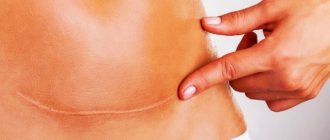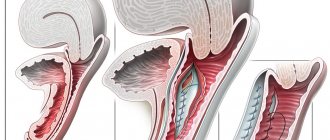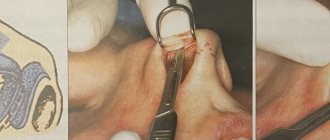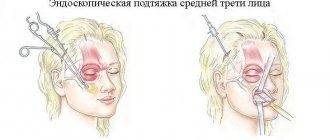Bone atrophy in the area of the alveolar processes of the upper and lower jaws is a fairly common occurrence among dental patients. This problem especially often develops in people with missing teeth (one or more). It is necessary to treat the problem as soon as possible, since it is constantly progressing and does not allow a number of surgical interventions on the teeth, in particular dental implantation.
Bone resorption is accompanied by a general deterioration in human health, as the chewing function, and therefore the digestive system, suffers. In addition, this phenomenon provokes sagging skin, deformation of facial muscles and loss of facial symmetry. In advanced situations, patients suffer from speech and even respiratory function. Elimination of atrophic phenomena in the alveolar ridges is carried out using osteoplastic operations. In such surgical interventions, the recovery period is important, improper management of which leads to the cancellation of treatment results.
General information about bone grafting
Bone grafting is a common dental surgery to restore the volume of bone tissue in the jaws. This surgical intervention allows you to restore the patient’s dentition in the most physiological way possible through dental implantation (it is carried out together with bone grafting or after it). This treatment has many advantages over the installation of removable dentures, including the aesthetics of the smile and the correct distribution of chewing loads.
There are several osteoplastic techniques:
- Splitting of the alveolar ridge (the graft is immersed in the cancellous part of the bone, where it quickly and fully takes root);
- Replanting a bone block (engraftment is a little worse, since the graft is fixed on the side of the bone where there are practically no vessels, so it is advisable to use the patient’s own tissue);
- Guided tissue regeneration (a technique in which a very high-quality graft is used, and a positive result is guaranteed by fixation of a collagen protective membrane);
- Sinus lifting (surgery on the upper jaw, which involves the bottom of the maxillary sinus).
The dentist chooses the appropriate bone restoration technique independently. But no matter what technique he chooses, recovery after surgery will be the same everywhere. The patient should not forget that the procedure itself is not a 100% result. It is equally important to follow all the dentist’s prescriptions, including taking medications after bone grafting and sinus lifting (the most common bone restoration procedure).
How to properly deal with apnea and snoring?
Today, there are many ways to treat snoring and sleep apnea, including both conservative and radical surgical methods. Supporters of “tough” measures ask the question “how to deal with snoring?” is solved with the help of surgical procedures that eliminate its anatomical cause. However, although surgical methods show good results in the fight against regular snoring, none of them are considered sufficiently effective in the treatment of apnea, so in the presence of severe obstructive sleep apnea, surgical treatment is not indicated. Therefore, you should never resort to the help of a surgeon without a thorough preliminary examination.
The modern, optimal and most effective method of treating moderate and severe apnea is CPAP therapy. At the same time, it is initially assumed that after the doctor selects the optimal treatment regimen, the patient can buy such a CPAP for subsequent home use, which makes the treatment of snoring more convenient, and getting rid of sleep apnea reliable and promising.
Do you snore? Are you planning a surgical operation that will be performed under general anesthesia? Get diagnosed and, if necessary, select treatment in our somnology laboratory and, perhaps, this will save you from serious problems.
What is a sinus lift?
One of the most modern and safe operations to correct bone tissue in the alveolar processes is sinus lifting. It is a surgical intervention on the upper jaw, during which the bottom of the maxillary sinus is raised, and osteoplastic material is inserted into the resulting cavity. Rehabilitation after such an operation involves long-term adherence to certain rules and taking medications, for which the patient must be prepared.
Sinus lifting can be open or closed. The first involves the correction of large volumes of the alveolar ridge, and the second allows for immediate implantation of artificial roots. Sinus lift techniques are constantly being modified, so patients can be confident in the safety of surgery.
Rehabilitation after surgery
The recovery period after bone grafting and sinus lifting includes many nuances and components. Control visits to the dentist, who will assess the dynamics of rehabilitation and correct it, are important. In addition, the doctor looks at the condition of the graft and its survival rate using instrumental studies.
Recommendations during the recovery period are general and specific to the oral cavity. The general pattern of behavior after surgery includes the following principles:
- Quitting smoking;
- Limiting physical activity;
- Avoidance of air travel;
- Refusal from diving;
- Limiting ultraviolet radiation (going to the solarium is prohibited);
- Coughing and sneezing should be done with caution and with the mouth open;
- It is forbidden to blow your nose;
- You should not drink through a straw, as the pressure in the mouth increases;
- Food should be finely ground and warm, but not hot.
Particular attention is paid to proper oral care during the rehabilitation period. The dentist must instruct the patient in detail about all the nuances of this process:
- The operated area is cleaned using a cotton swab and an antiseptic solution (movements should be gentle, in the form of blotting, not rubbing);
- The teeth are cleaned with a soft toothbrush for several weeks after surgery (the postoperative wound is not affected);
- During the day, the oral cavity is treated with an antiseptic solution (but without rinsing);
- Chewing is carried out only on the healthy side (at least a few weeks after bone grafting).
However, the rehabilitation period after bone grafting and sinus lifting, as with any surgical intervention, involves taking a number of medications. The patient should not prescribe or use medications on his own, as this may cause irreparable harm to his own health.
What medications should I take?
The rehabilitation period after bone grafting and sinus lifting includes the mandatory use of certain groups of medications. The doctor prescribes individual representatives individually, but the general scheme during rehabilitation is as follows:
- Antibacterial agents. Every patient takes such medications after bone grafting and sinus lifting, as they represent the main prevention of the development of an infectious process. The standard course involves a five-day intake of broad-spectrum agents.
- Antihistamines. These medications help reduce the activity of the inflammatory process and, accordingly, reduce the edema syndrome. They are taken for 3 days in a standard dosage.
- NSAIDs. Nonsteroidal anti-inflammatory drugs help reduce swelling and inhibit the production of inflammatory mediators. On average, such medications are taken for 3-4 days.
- Analgesics. Painkillers are not included in the course of pathogenetic and etiological therapy during the recovery period, since they relieve only the symptom of pain. They are taken during the first week after surgery (during this period the discomfort should completely disappear) or even less. The doctor himself selects the appropriate drug for the patient and prescribes its dosage. It is forbidden to exceed the maximum daily dose and drink large amounts of medicine at a time. If the doctor forgot to tell you about the rules for taking analgesics, then the patient follows the instructions.
- Healing ointments. Special means to accelerate regeneration are used topically - smeared on the postoperative wound. Their use increases the regenerative abilities of tissues, and epithelization occurs faster. The doctor prescribes one, and sometimes even two drugs, which should be used according to a certain scheme.
- Antiseptic. A solution of Chlorhexidine or any other antiseptic is used for oral care. It is forbidden to rinse your mouth, but it is recommended to treat it and the wound surface in particular with this product after each meal.
- Calcium preparations. Bone grafting involves damage to bone structures. In addition, the condition of the teeth also requires some kind of replenishment. Not only calcium supplements, but also foods rich in calcium do an excellent job of this. This includes: cottage cheese, sour cream, milk and other dairy products.
- Vitamin C. Ascorbic acid helps not only improve immunity, as many believe, but also accelerate regeneration and improve overall metabolism. It is an indispensable component of any course that involves exhaustion of the body.
Each of the listed drugs helps to shorten the rehabilitation period and its successful course. You cannot ignore any of the dentist’s prescriptions, as this can lead to the development of various complications and unfavorable outcomes.
Types of general anesthesia
Depending on the method of administering drugs for general anesthesia, inhalation and intravenous anesthesia are distinguished.
With inhalation anesthesia, the anesthetic enters the body through the respiratory tract; with intravenous anesthesia, it is injected into the bloodstream. A combined method involving inhalation and intravenous administration of the drug is actively used. To maintain external respiration, an endotracheal tube or laryngeal mask is used. The first method is called intubation anesthesia (or endotracheal), the second - mask. You will not need deeper knowledge about the specifics of an anesthesiologist’s work; it is much more important to understand how to properly prepare for anesthesia.
Good general anesthesia is the result of the consolidated efforts of the anesthesiologist and the patient. Therefore, we recommend that you read the next section very carefully.










